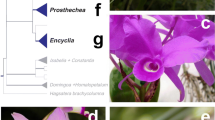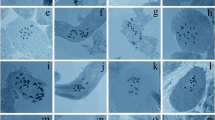Abstract
Aristolochia is the largest genus of the family Aristolochiaceae and the only one with large chromosome number variation. A combination of fluorochrome banding and in situ hybridization of 5S and 45S rDNA probes was used to evaluate the structural karyotype variability of representatives of two subgenera: Siphisia, which seems to have a single chromosome number (2n = 32), probably derived from an old polyploidization event, and Aristolochia, including the Old World section Diplolobus and the New World Gymnolobus. Based on chromosome morphology and on the degree of diploidization of rDNA sites, A. serpentaria (Siphisia) was identified as an old hexaploid, whereas A. paucinervis (Diplolobus) seemed to be a recent hexaploid (2n = 34). The karyotypes of the five analyzed species of section Gymnolobus were structurally more stable than those from Diplolobus, which varied considerably in the type of heterochromatin, chromosome number, and morphology. These data indicate that fluorochrome banding and rDNA localization may substantially improve the cytotaxonomical analysis of this genus.



Similar content being viewed by others
References
Almeida CCS, Carvalho PCL, Guerra M (2007) Karyotype differentiation among Spondias species and the putative hybrid Umbu-cajá (Anacardiaceae). Bot J Linn Soc 155:541–547
Besendorfer V, Samardzija M, Zoldos V, Solic ME, Papes D (2002) Chromosomal organization of ribosomal genes and NOR-associated heterochromatin, and NOR activity in some populations of Allium commutatum Guss. (Alliaceae). Bot J Linn Soc 139:99–108
Brasileiro-Vidal AC, dos Santos-Serejo JA, Soares Filho WS, Guerra M (2007) A simple chromosomal marker can reliably distinguishes Poncirus from Citrus species. Genetica 129:273–279
Cabral JS, Felix LP, Guerra M (2006) Heterochromatin diversity and its co-localization with 5S and 45S rDNA sites in chromosomes of four Maxillaria species (Orchidaceae). Genet Mol Biol 29:659–664
Clarkson JJ, Lim KY, Kovarik A, Chase MW, Knapp S, Leitch AR (2005) Long-term genome diploidization in allopolyploid Nicotiana section Repandae (Solanaceae). New Phytol 168:241–252
De Groot H, Wanke S, Neinhuis C (2006) Revision of the genus Aristolochia (Aristolochiaceae) in Africa, Madagascar and adjacent islands. Bot J Linn Soc 151:219–238
de Melo NF, Guerra M (2003) Variability of the 5S and 45S rDNA sites in Passiflora L. species with distinct base chromosome numbers. Ann Bot 92:309–316
de Moraes AP, Soares Filho WS, Guerra M (2007) Karyotype diversity and the origin of grapefruit. Chromosome Res 15:115–121
Fregonezi JN, Fernandes T, Torezan JMD, Vieira AOS, Vanzela ALL (2006) Karyotype differentiation of four Cestrum species (Solanaceae) based on the physical mapping of repetitive DNA. Genet Mol Biol 29:97–104
González F (1999) Inflorescence morphology and the systematics of Aristolochiaceae. Syst Geogr Plant 68:159–172
González F, Stevenson DW (2000) Perianth development and systematics of Aristolochia. Flora 195:370–391
Grant V (1982) Periodicities in the chromosome numbers of the angiosperms. Bot Gaz 143:379–389
Gregory MP (1956) A phyletic rearrangement in the Aristolochiaceae. Am J Bot 43:110–122
Guerra M (2000) Patterns of heterochromatin distribution in plant chromosomes. Genet Mol Biol 23:1029–1041
Guerra M (2008) Chromosome numbers in plant cytotaxonomy: concepts and implications. Cytogenet Genome Res 120:339–350
Jaramillo MA, Kramer EM (2004) APETALA3 and PISTILLATA homologs exhibit novel expression patterns in the unique perianth of Aristolochia (Aristolochiaceae). Evol Dev 6:449–458
Kelly LM, González F (2003) Phylogenetic relationships in Aristolochiaceae. Syst Bot 28:236–249
Ma JS (1989) A revision of Aristolochia Linn. from E. & S. Asia. Acta Phytotaxon Sin 27:321–364
Morawetz W (1985) Beiträge zur Karyologie und Systematik der Gattung Thottea (Aristolochiaceae). Bot Jahrb Syst 107:329–342
Moscone EA, Matzke MA, Matzke AJM (1996) The use of combined FISH/GISH in conjunction with DAPI counterstaining to identify chromosomes containing transgene inserts in amphidiploid tobacco. Chromosoma 105:231–236
Na H, Kondo K (1994) A comparison of chromosome variability in Asarum asperum and A. hexalobum (Aristolochiaceae). Cytol 59:165–173
Nardi E (1984) The genus Aristolochia L. (Aristolochiaceae) in Italy. Webbia 38:221–300
Neinhuis C, Wanke S, Hilu KW, Müller K, Borsch T (2005) Phylogeny of Aristolochiaceae based on parsimony, likelihood, and Bayesian analyses of trnL–trnF sequences. Plant Syst Evol 250:7–26
Ohi-Toma T, Sugawara T, Murata H, Wanke S, Neinhuis C, Murata J (2006) Molecular phylogeny of Aristolochia sensu lato (Aristolochiaceae) based on sequences of rbcL, matK, and phyA genes, with special reference to differentiation of chromosome numbers. Syst Bot 31:481–492
Pedrosa-Harand A, de Almeida CCS, Mosiolek M, Blair MW, Schweizer D, Guerra M (2006) Extensive ribosomal DNA amplification during Andean common bean (Phaseolus vulgaris L.) evolution. Theor Appl Genet 112:924–933
Raskina O, Belyayev A, Nevo E (2004) Quantum speciation in Aegilops: Molecular cytogenetic evidence from rDNA cluster variability in natural populations. Proc Natl Acad Sci 101:14818–14823
Raskina O, Barber JC, Nevo E, Belyayev A (2008) Repetitive DNA and chromosomal rearrangements: speciation-related events in plant genomes. Cytogenet Genome Res 120:351–357
Sakai S (2002) Aristolochia spp. (Aristolochiaceae) pollinated by flies breeding on decomposing flowers in Panama. Am J Bot 89:527–534
Schweizer D (1976) Reverse fluorescent chromosome banding with Chromomycin and DAPI. Chromosoma 58:307–324
Soltis DE (1984) Karyotypes of species of Asarum and Hexastylis (Aristolochiaceae). Syst Bot 9:490–493
Stellari GM, Jaramillo MA, Kramer EM (2004) Evolution of the APETALA3 and PISTILLATA lineages of MADS-box-containing genes in the basal angiosperms. Mol Biol Evol 21:506–519
Sugawara T, Murata H (1992) Chromosome numbers of eight species of Aristolochia (Aristolochiaceae) from east Asia. Acta Phytotaxon Geobot 43:27–30
Sugawara T, Murata J, Wu S, Ohi T, Nakanishi T, Murata H (2001) A cytological analysis of 24 taxa in Aristolochia subgenera Siphisia and Aristolochia (Aristolochiaceae). Acta Phytotaxon Geobot 52:149–158
Vaio M, Speranza P, Valls JF, Guerra M, Mazzella C (2005) Localization of the 5S and 45S rDNA sites and cpDNA sequence analysis in species of the Quadrifaria group of Paspalum (Poaceae, Paniceae). Ann Bot 96:191–200
Wanke S, González F, Neinhuis C (2006) Systematics of pipevines: combining morphological and fast-evolving molecular characters to investigate the relationships within subfamily Aristolochioideae (Aristolochiaceae). Int J Plant Sci 167:1215–1227
Weiss-Schneeweiss H, Tremetsberger K, Schneeweiss GM, Parker JS, Stuessy TF (2008) Karyotype diversification and evolution in diploid and polyploid South American Hypochaeris (Asteraceae) inferred from rDNA localization and genetic fingerprint data. Ann Bot 101:909–918
Acknowledgments
The authors wish to thank Conselho Nacional de Desenvolvimento Científico e Tecnológico (Brazil), Fundação de Amparo à Ciência e Tecnologia de Pernambuco (Brazil), and Ministerio de Ciencia e Innovación (Spain) for their financial support, and to Dr. Leonardo Felix, Dr. Juliano Cabral, and Dr. Santiago Castroviejo for their kind help in collecting the plant material.
Author information
Authors and Affiliations
Corresponding author
Rights and permissions
About this article
Cite this article
Berjano, R., Roa, F., Talavera, S. et al. Cytotaxonomy of diploid and polyploid Aristolochia (Aristolochiaceae) species based on the distribution of CMA/DAPI bands and 5S and 45S rDNA sites. Plant Syst Evol 280, 219–227 (2009). https://doi.org/10.1007/s00606-009-0184-6
Received:
Accepted:
Published:
Issue Date:
DOI: https://doi.org/10.1007/s00606-009-0184-6




